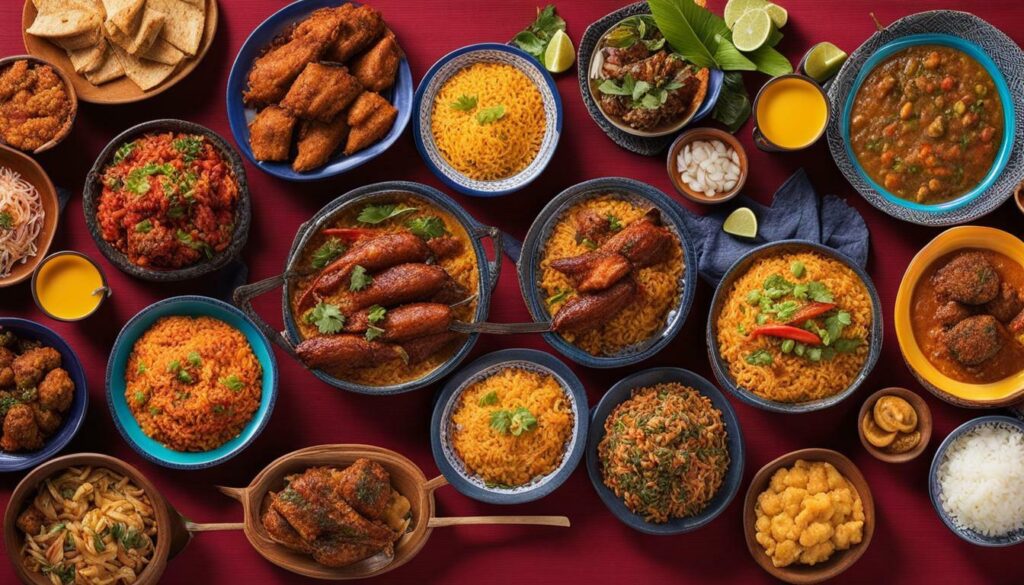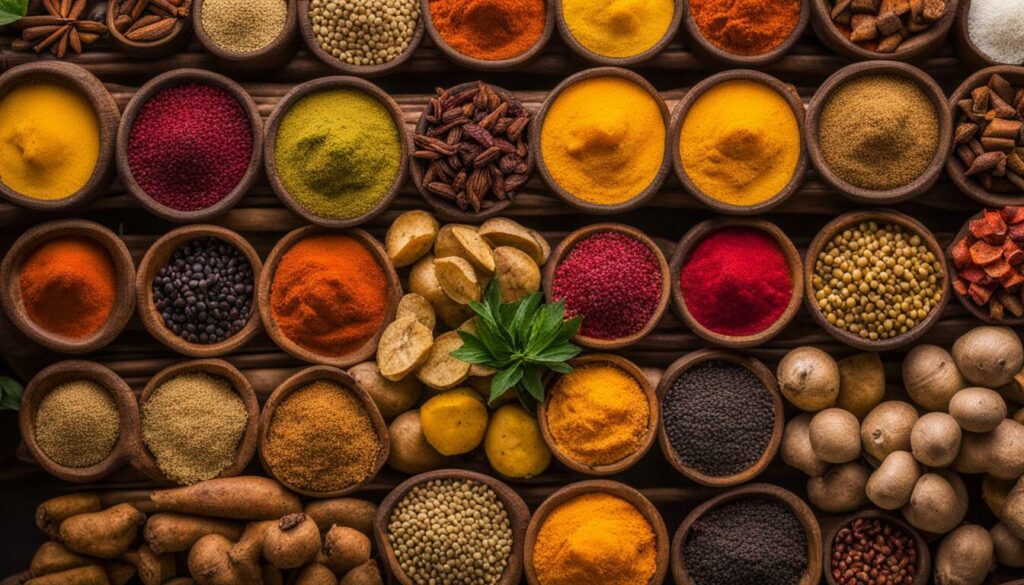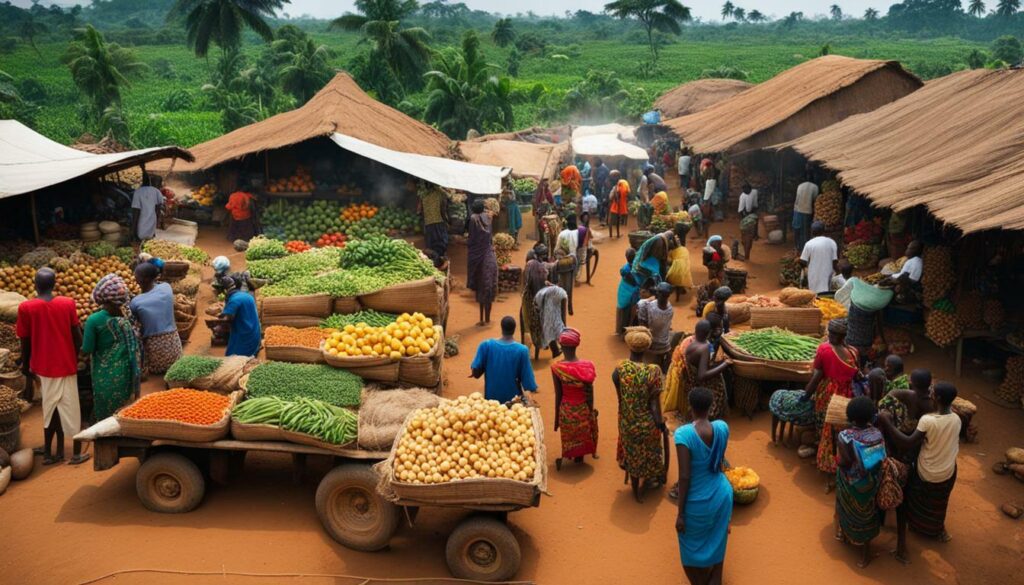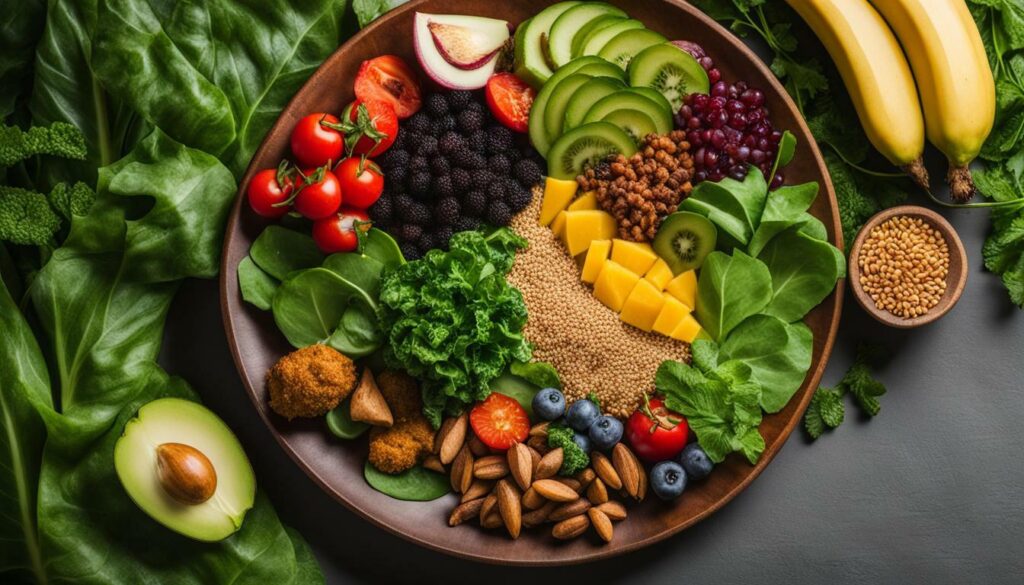Ghanaian cuisine has a rich history and is deeply rooted in traditional foods that have been enjoyed for generations. The history of food in Ghana is a fascinating journey that reflects the cultural diversity and culinary heritage of the country. Traditional Ghanaian foods play a significant role in Ghanaian daily life, with their unique flavours and vibrant ingredients. In this article, we will explore the past and present diets of Ghana, delving into the history of food in Ghana, the significance of traditional Ghanaian foods, and the evolution of Ghanaian cuisine.
Key Takeaways:
- Ghanaian cuisine is known for its spice and robust flavours, with dishes often consisting of stews and swallows made from grains and starches.
- Common ingredients in Ghanaian cuisine include tomatoes, onion, pepper, ginger, palm oil, and fermented spices.
- Street food is an integral part of Ghanaian daily life and offers a wide variety of quick and affordable bites.
- Popular street foods include waakye, kelewele, banku, and shito.
- When exploring Ghana’s street food scene, it’s important to be adventurous, use your senses, and be mindful of spice levels.
Traditional Foods of Ghana
Traditional foods play a central role in Ghanaian culture and reflect the country’s diverse culinary heritage. Ghanaian cuisine is known for its spice and robust flavours, with dishes often consisting of stews and swallows made from grains and starches. Some common ingredients include tomatoes, onions, pepper, ginger, and palm oil, as well as fermented spices. These ingredients come together to create mouthwatering dishes that are enjoyed by Ghanaians and celebrated around the world.
When exploring the traditional foods of Ghana, one cannot ignore the vibrant street food scene. Street food is an integral part of Ghanaian daily life, offering quick and affordable bites. It is a bustling and sensory experience, where the tantalizing aromas of sizzling meats and aromatic spices fill the air. Ghanaians pride themselves on their street food culture, which showcases the rich flavours and culinary ingenuity of the country.
Popular traditional foods in Ghana include waakye, a dish of rice and beans cooked together and served with a variety of toppings, such as fried plantains, spaghetti, and a spicy black pepper sauce called shito. Another beloved dish is banku, which is made from fermented corn and cassava dough and is often served with grilled tilapia fish. Kelewele, spicy fried plantains, is a favourite street food snack, offering a delightful combination of sweetness and heat.
| Dish | Description |
|---|---|
| Waakye | A popular dish made from rice and beans, often served with fried plantains, spaghetti, and shito. |
| Banku | A staple in Ghanaian cuisine, made from fermented corn and cassava dough, often paired with grilled tilapia. |
| Kelewele | Spicy fried plantains, a beloved street food snack in Ghana, offering a delightful combination of sweetness and heat. |

When exploring Ghana’s street food scene, it’s important to be adventurous, use your senses, and be mindful of spice levels. Ghanaians take great pride in their culinary traditions and are always eager to share their delicious food with visitors. Whether you are enjoying a hearty bowl of waakye, savouring the flavours of grilled tilapia and banku, or indulging in the spicy goodness of kelewele, Ghanaian traditional foods offer a culinary experience that is both rich in flavour and steeped in cultural significance.
Evolution of Ghanaian Cuisine
Over the years, Ghanaian cuisine has undergone significant changes, reflecting the dynamic nature of the country’s food culture. Influenced by historical events, globalisation, and urbanisation, the Ghanaian diet has evolved to incorporate new ingredients and cooking techniques while retaining its traditional roots.
Colonization played a significant role in shaping the evolution of Ghanaian cuisine. The introduction of European ingredients such as tomatoes and potatoes during the colonial era led to the creation of new dishes that blended local and foreign flavours. This fusion is evident in popular Ghanaian dishes like jollof rice, a flavorful one-pot dish that showcases the influence of West African and European cooking styles.
The impact of globalization has further expanded the culinary landscape of Ghana. As the country becomes more connected to the international community, Ghanaians have embraced dishes from around the world and incorporated them into their daily diets. Western fast-food chains, for example, have gained popularity in urban areas, offering a taste of global cuisine alongside traditional Ghanaian fare.
“Ghanaian cuisine is a beautiful blend of tradition and innovation. It celebrates our rich culinary heritage while embracing new flavors and influences.”
Despite these changes, traditional Ghanaian foods remain an integral part of the country’s culinary identity. Dishes like fufu, banku, and kenkey continue to be enjoyed across the country, cherished for their cultural significance and delicious taste. These dishes are often made from locally sourced ingredients, highlighting the importance of sustainability and supporting local farmers.
| Dish | Main Ingredients | Region |
|---|---|---|
| Fufu | Cassava and plantain | Throughout Ghana |
| Banku | Corn dough and cassava dough | Greater Accra Region |
| Kenkey | Fermented corn dough | Central and Greater Accra Regions |
The evolution of Ghanaian cuisine is an ongoing process, with continued exploration and experimentation. As Ghanaians embrace their culinary heritage while embracing new flavours, the future of Ghanaian cuisine promises to be an exciting blend of tradition and innovation.

Festive Foods in Ghana
Festivals in Ghana are marked by a variety of mouthwatering dishes that are eagerly anticipated by locals and visitors alike. These special occasions offer a unique opportunity to sample the rich and diverse flavours of Ghanaian cuisine. From hearty stews to grilled delicacies, festive foods in Ghana showcase the country’s culinary heritage and celebration of food.
One popular dish that is often enjoyed during festivals is jollof rice, a flavorful and fragrant rice dish cooked in tomato sauce and spices. This iconic Ghanaian dish is often served with grilled chicken or beef, creating a satisfying and delicious meal. Another festive favourite is fufu, a traditional Ghanaian dish made from pounded cassava and plantains. It is typically served with a rich soup or stew, such as groundnut soup or palm nut soup, adding depth of flavour and a comforting element to the meal.
| Dish | Description |
|---|---|
| Banku and Tilapia | A popular combination of fermented corn and cassava dough served with grilled tilapia fish |
| Kelewele | Spicy fried plantains seasoned with ginger, pepper, and other spices |
| Waakye | A one-pot dish of rice and beans, cooked with spices and served with a variety of accompaniments |
“Ghanaian festivals are a vibrant celebration of culture and food. The festive foods reflect the diversity of the country’s culinary traditions and are a testament to the rich flavors and traditions of Ghanaian cuisine.” – A local food enthusiast
During these festive occasions, street food stalls come alive, offering an array of delectable treats. From grilled kebabs to freshly fried plantains, the streets are filled with tantalizing aromas and the hustle and bustle of eager customers. Festivals provide a unique opportunity to immerse oneself in the vibrant street food culture of Ghana, exploring the tantalizing flavours and experiencing the lively atmosphere.
As you can see, festive foods play a significant role in Ghanaian culture and are cherished by both locals and visitors. The rich flavours, vibrant colours, and unique combinations of ingredients make Ghanaian cuisine a truly unforgettable experience. Whether you’re enjoying jollof rice at a festival or sampling street food delicacies, each bite tells a story of tradition, community, and the love for good food in Ghana.

Street Food in Ghana
Ghana’s bustling street food scene is a sensory feast, offering a taste of the country’s culinary diversity and local flavours. The streets of Ghana’s cities and towns come alive with the aromas of sizzling meats, and spices, and the sound of vendors calling out their mouth-watering offerings. Street food is not only a convenient and affordable option for locals, but it also provides visitors with an opportunity to immerse themselves in Ghanaian culture.
One popular street food in Ghana is waakye, a hearty dish made of rice and beans, typically served with a tomato-based sauce and a side of spaghetti. The rice and beans are cooked together, making the dish distinctive reddish-brown colour. Waakye is often garnished with fried plantains, boiled eggs, and avocado, adding layers of flavour and texture to each bite. It’s a satisfying and filling meal that can be enjoyed at any time of the day.
Another mouth-watering street food option is kelewele, spicy fried plantains. The plantains are seasoned with a blend of ginger, garlic, and cayenne pepper before being deep-fried to perfection. The result is a crispy and flavorful snack that packs a punch. Kelewele is often enjoyed on its own or as a side dish, complementing other street food favourites.
When venturing into Ghana’s street food scene, don’t miss out on the classic combination of banku and grilled tilapia. Banku is a fermented corn and cassava dough that is cooked and shaped into balls. It is typically served with grilled tilapia, marinated in a blend of spices and grilled to perfection. The combination of the soft and slightly sour banku with the smoky and flavorful fish is a true delight for the taste buds. Don’t forget to top it off with a generous serving of shito, a spicy pepper sauce that adds an extra kick to the dish.
Ghanaian street food is not just about the flavours; it’s also about the experience. Whether you’re exploring the stalls at night markets or stopping by a roadside vendor during the day, the vibrant atmosphere and the friendly vendors make the experience memorable. From the sizzling sounds of grills to the tantalizing smells wafting through the air, Ghana’s street food scene offers a culinary adventure that shouldn’t be missed.
| Popular Ghanaian Street Foods | Description |
|---|---|
| Waakye | A dish made of rice and beans, typically served with a tomato-based sauce and garnished with fried plantains, eggs, and avocado. |
| Kelewele | Spicy fried plantains seasoned with a blend of ginger, garlic, and cayenne pepper. |
| Banku with Grilled Tilapia | Fermented corn and cassava dough served with grilled tilapia, marinated in spices and topped with shito, a spicy pepper sauce. |
So, if you find yourself in Ghana, be sure to indulge in the vibrant street food scene. From the rich flavours to the friendly atmosphere, it’s an experience that will leave you craving for more.

Ghanaian Recipes to Try
Embark on a culinary adventure by trying these authentic Ghanaian recipes in your own kitchen. Ghanaian cuisine is known for its spice and robust flavours, with dishes often consisting of stews and swallows made from grains and starches. Some common ingredients include tomatoes, onion, pepper, ginger, and palm oil, as well as fermented spices. Below are a few traditional recipes that showcase the rich flavours of Ghana.
Jollof Rice
Jollof rice is a popular one-pot dish that is enjoyed across West Africa, including Ghana. This flavorful rice dish is made with long-grain rice cooked in a rich tomato-based sauce infused with spices and vegetables. It is often served with grilled chicken or fish and enjoyed by families and friends at social gatherings. Try your hand at making this iconic Ghanaian dish and savour the delicious combination of flavours.
“Jollof rice is a staple in Ghanaian households, and no celebration is complete without it. The secret to a great jollof rice lies in the combination of spices and the slow cooking process, allowing the flavors to meld together perfectly.”
Kelewele
Kelewele is a popular street food snack in Ghana, made from ripe plantains that are marinated in a blend of spices and deep-fried until golden and crispy. The result is a mouthwatering combination of sweet and savoury flavours that is sure to tantalize your taste buds. Kelewele is often enjoyed on its own as a snack or served alongside a main meal as a flavorful side dish.
Banku and Grilled Tilapia
Banku is a traditional Ghanaian dish made from fermented corn and cassava dough. It is typically served with grilled tilapia fish, creating a delicious and satisfying meal. The banku is soft and slightly sour, while the grilled tilapia is seasoned with spices and cooked to perfection. This dish is a favourite among Ghanaians and offers a delightful combination of flavours and textures that is sure to impress.
Embrace the vibrant flavours of Ghanaian cuisine by preparing these authentic recipes in your own kitchen. Whether you’re a seasoned chef or just starting out, these Ghanaian dishes will transport you to the heart of West Africa and leave you craving for more. Get ready to embark on a culinary journey and explore the diverse and delicious world of Ghanaian cuisine.

Influences on Modern Ghanaian Diets
The culinary landscape of Ghana is continuously evolving, with a diverse range of influences shaping modern Ghanaian diets. These influences can be attributed to factors such as globalization, migration, and changing societal trends. As Ghana becomes more interconnected with the rest of the world, its cuisine has undergone significant transformations, incorporating new ingredients and cooking styles.
One prominent influence on modern Ghanaian diets is globalisation. Increased access to international ingredients and culinary traditions has sparked a fusion of flavours and techniques in Ghanaian cuisine. Chefs and home cooks alike are experimenting with new ingredients, combining traditional Ghanaian flavours with international twists. This has resulted in unique dishes that reflect the multicultural nature of Ghanaian society.
Migration has also played a role in shaping Ghanaian food culture. Ghanaians living abroad often bring back new culinary experiences and ideas, infusing their traditional dishes with influences from their host countries. This cross-pollination of food cultures has led to the emergence of innovative and diverse recipes, expanding the culinary repertoire of Ghanaian cuisine.
Furthermore, changing societal trends have influenced the way Ghanaians eat. With the rise of urbanization and busy lifestyles, convenience foods and fast food chains have become more prevalent. This shift towards processed and unhealthy food choices has raised concerns about the impact on public health. However, there is also a growing movement towards embracing traditional and locally sourced ingredients, encouraging sustainable food practices and promoting the preservation of Ghanaian culinary heritage.
Globalization
Globalization has had a significant impact on Ghanaian diets, exposing Ghanaians to a wider range of ingredients and cooking techniques. The influx of international flavours has led to the incorporation of spices, herbs, and ingredients from different cultures. The blending of these diverse influences has created a unique and flavorful fusion of Ghanaian and international cuisines.

- Increased access to international ingredients and culinary traditions.
- Migration and the exchange of culinary experiences.
- Changing societal trends, including urbanization and convenience food culture.
Despite the changes and influences, traditional Ghanaian cuisine remains at the heart of Ghanaian culture. From the rich stews to the staple grains and the vibrant street food scene, Ghanaian food continues to reflect the country’s history, diversity, and unique culinary heritage. As the future unfolds, it will be interesting to see how Ghanaian cuisine evolves and adapts to the ever-changing global food landscape.
Health Aspects of Ghanaian Diets
Ghanaian diets are not only flavorful but also offer numerous health benefits, thanks to the use of fresh ingredients and traditional cooking techniques. The rich and varied culinary heritage of Ghana incorporates a wide range of nutritious foods that promote overall well-being.
Traditional Ghanaian cuisine is characterized by the use of fresh fruits and vegetables, whole grains, and lean proteins. These staple ingredients provide essential vitamins, minerals, and dietary fibre, contributing to a well-rounded and balanced approach to eating. The emphasis on locally sourced and seasonal produce ensures that Ghanaians have access to nutrient-dense foods throughout the year.
Additionally, the traditional cooking methods in Ghana, such as steaming, grilling, and stewing, help to retain the nutritional value of the ingredients. These methods minimize the need for excessive oil or frying, resulting in healthier and lighter dishes. The use of herbs and spices, such as ginger, garlic, and turmeric, adds not only flavour but also potential health benefits, as many of these ingredients are known for their antioxidant and anti-inflammatory properties.
| Nutrient | Source | Health Benefits |
|---|---|---|
| Vitamin C | Citrus fruits, tomatoes | Boosts immune system, aids in collagen production |
| Vitamin A | Carrots, leafy greens | Supports healthy vision, promotes cell growth |
| Fibre | Whole grains, legumes | Improves digestion, regulates blood sugar levels |
| Protein | Beans, fish, poultry | Builds and repairs tissues, supports growth |
Ghanaian diets are also abundant in omega-3 fatty acids, thanks to the consumption of fish, particularly the popular grilled tilapia. Omega-3 fatty acids are known for their role in promoting heart health, reducing inflammation, and supporting brain function.
By embracing the health aspects of Ghanaian diets, individuals can enjoy delicious traditional dishes while nourishing their bodies with wholesome ingredients. From the vibrant street food scene to festive and celebratory foods, Ghanaian cuisine offers a diverse range of options that cater to both taste and health.

“The combination of fresh ingredients, traditional cooking methods, and flavorful spices in Ghanaian cuisine makes it a true culinary treasure that not only tantalizes the taste buds but also provides a host of health benefits.” – Dr. Grace Adwoa Amoako, Nutritionist
Sustainable Food Practices in Ghana
Ghana is embracing sustainable food practices as a means to protect the environment and preserve traditional agricultural methods. With a growing awareness of the impact of food production on the planet, Ghanaians are turning to sustainable farming techniques, organic farming, and the preservation of indigenous crops. These practices not only contribute to the long-term health of the ecosystem but also promote healthier and more nutritious food choices.
One example of sustainable food practices in Ghana is the rise of organic farming. Farmers are adopting organic methods, including natural pest control, composting, and crop rotation, to minimize the use of synthetic chemicals and promote soil fertility. By avoiding chemical fertilizers and pesticides, organic farming helps to preserve the biodiversity of the land and reduce the environmental impact of agriculture. Additionally, organic produce tends to be more nutrient-dense and free from harmful residues, making it a healthier choice for consumers.
Another sustainable practice gaining momentum in Ghana is the farm-to-table movement. This concept emphasizes the consumption of locally grown and produced food, reducing the carbon footprint associated with long-distance transportation. By supporting local farmers and producers, Ghanaians are not only reducing their impact on the environment but also fostering a sense of community and supporting the local economy. Farmers’ markets and community-supported agriculture programs are becoming increasingly popular, providing direct access to fresh and seasonal produce.
Ghana is also recognizing the importance of preserving indigenous crops and traditional farming knowledge. Many small-scale farmers are growing and cultivating indigenous crops that are well-suited to the local climate and resistant to pests and diseases. By preserving these crops, Ghanaians are safeguarding their cultural heritage and maintaining a diverse and resilient food system. Furthermore, the cultivation of indigenous crops contributes to food security and reduces dependence on imported varieties.

In conclusion, Ghana’s commitment to sustainable food practices is evident in the adoption of organic farming, the farm-to-table movement, and the preservation of indigenous crops. These practices not only protect the environment but also promote healthier food choices and support local communities. By embracing sustainable agriculture, Ghana is ensuring a brighter and more sustainable future for its food system.
Future of Ghanaian Diets
As Ghana continues to evolve, the future of its diets holds exciting possibilities, with a blend of tradition and innovation. Ghanaian cuisine is deeply rooted in the country’s rich cultural heritage, with an emphasis on utilizing local ingredients and traditional cooking methods. However, as Ghana becomes more interconnected with the global community, there is a growing influence of international flavours and culinary trends.
One potential trend for the future of Ghanaian diets is the fusion of traditional Ghanaian cuisine with international flavours. This can be seen in the rise of restaurants and chefs who are combining local ingredients and cooking techniques with global influences. The result is a vibrant and diverse culinary landscape that showcases the best of both worlds.
Another aspect that is likely to shape the future of Ghanaian diets is the increasing focus on health and wellness. As people become more conscious of the impact of their food choices on their well-being, there is a growing demand for nutritious and balanced meals. Ghanaian cuisine, with its emphasis on fresh produce, whole grains, and lean proteins, is well-positioned to cater to this trend.
Sustainable food practices are also gaining traction in Ghana, with a focus on organic farming, responsible sourcing, and reducing food waste. These practices not only promote environmental sustainability but also contribute to the preservation of Ghana’s unique culinary heritage. As more consumers prioritize sustainability in their food choices, it is likely that these practices will continue to grow and shape the future of Ghanaian diets.

Conclusion
The past and present diets of Ghana reflect a vibrant tapestry of flavours, traditions, and cultural influences that continue to shape the country’s culinary identity. Ghanaian cuisine is known for its spice and robust flavours, with dishes often consisting of stews and swallows made from grains and starches. Some common ingredients include tomatoes, onions, pepper, ginger, and palm oil, as well as fermented spices.
Street food is an integral part of Ghanaian daily life, offering quick and affordable bites. Popular street foods include waakye, a dish of rice and beans, kelewele, spicy fried plantains, and banku paired with grilled tilapia. Shito, a fiery pepper sauce, is a ubiquitous accompaniment. When exploring Ghana’s street food scene, it’s important to be adventurous, use your senses, and be mindful of spice levels. Overall, Ghanaian street food offers a culinary adventure with diverse flavours and unique experiences.
As Ghanaian cuisine has evolved over time, influenced by factors such as colonization, globalization, and urbanization, new ingredients and cooking techniques have been introduced, alongside the impact of Western influences on traditional Ghanaian diets. Festive foods are also an important part of Ghanaian culture, with specific dishes enjoyed during festivals and special occasions, showcasing the vibrant culinary traditions of the country.
Looking to the future, Ghanaian diets are likely to continue evolving, shaped by trends, challenges, and opportunities. Technology, changing consumer preferences, and global food systems will all play a part in shaping the future of Ghanaian cuisine. However, amidst this evolution, the importance of traditional Ghanaian foods and their cultural significance should not be forgotten, as they continue to provide a rich culinary heritage for future generations to enjoy.
FAQ
What is Ghanaian cuisine known for?
Ghanaian cuisine is known for its spice and robust flavours, with dishes often consisting of stews and swallows made from grains and starches.
What are some common ingredients in Ghanaian cuisine?
Some common ingredients in Ghanaian cuisine include tomatoes, onion, pepper, ginger, and palm oil, as well as fermented spices.
What is the significance of street food in Ghanaian daily life?
Street food is an integral part of Ghanaian daily life, offering quick and affordable bites.
What are some popular street foods in Ghana?
Popular street foods in Ghana include waakye, a dish of rice and beans, kelewele, spicy fried plantains, and banku paired with grilled tilapia.
What is shito?
Shito is a fiery pepper sauce that is a ubiquitous accompaniment in Ghanaian cuisine.
How can I navigate Ghana’s street food scene?
When exploring Ghana’s street food scene, it’s important to be adventurous, use your senses, and be mindful of spice levels.
What can I expect from Ghanaian street food?
Ghanaian street food offers a culinary adventure with diverse flavours and unique experiences.
Source Links
- http://www.foodbycountry.com/Germany-to-Japan/Ghana.html
- https://www.ciee.org/go-abroad/college-study-abroad/blog/exploring-ghanaian-cuisine
- https://www.gviusa.com/blog/smb-exploring-delicious-street-food-in-ghana/



